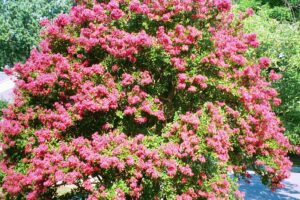 After about three years of indecision and inattention, I have finally acquired a crape myrtle, known to its botanist friends as Lagerstroemia indica. The acquisition involved aging by yet another year and alerting my daughter to the fact that a crape myrtle might make a wonderful birthday present. Now, I am the proud owner of ‘Pecos’, a deciduous tree that will be 10 feet tall and eight feet wide at maturity, but should present me with clear pink summer flowers by next year.
After about three years of indecision and inattention, I have finally acquired a crape myrtle, known to its botanist friends as Lagerstroemia indica. The acquisition involved aging by yet another year and alerting my daughter to the fact that a crape myrtle might make a wonderful birthday present. Now, I am the proud owner of ‘Pecos’, a deciduous tree that will be 10 feet tall and eight feet wide at maturity, but should present me with clear pink summer flowers by next year.
Growing up in the wilds of western New York State, crape myrtles were as foreign to me as winters without snow. I had a vague notion that in the South they were nearly as important as camellias, but even northeastern greenhouses that were chock full of camellias were devoid of crape myrtle.
I was well into adulthood before my horizons broadened. Making a home in a less frosty Mid-Atlantic state, I started to notice crape myrtles blooming in high summer, right alongside the roses-of-Sharon. My then-young daughter fell in love with them and would point out every single specimen that we encountered in our travels. It is only fitting that years later she was the one to give me a crape myrtle for our home garden.
Crape myrtles have proliferated in my area—so much so that now I sometimes see them at every turn. Some have shrubby habits, but most are grown as small trees, topping out anywhere from eight to about 25 feet, depending on variety. In late summer, those trees sport lush flower panicles composed of scores of individual six-petaled blooms in shades including white, a range of pinks and roses, dark red and lavender.
Mid-summer beauty is delightful, but those of us without large pieces of real estate need plants that can pull their weight in more than one season. Crape myrtle fills the bill. Most varieties have smooth grayish bark that exfoliates or peels off to reveal underbark that may be brown, gray or even pinkish. The effect is like elegant camouflage and is starkly beautiful in the winter when the branches are bare.
To add to the four-season equation, crape myrtle leaves, which are oblong and appear in groups of three, tend to be smooth and glossy, coloring up in the fall in shades of red, orange and yellow before leaving the scene for the winter.
The most common crape myrtles in commerce are varieties or hybrids of Lagerstroemia indica, which is native to parts of Asia, including China, Indo-China and Japan. The genus is named for Magnus von Lagerstroem, an eighteenth century Swedish botanist who also happened to be a friend of the great plant taxonomist Linnaeus. When you have chums like Linnaeus, it is almost inevitable that plants will be named for you. This is what happened to Lagerstroem, allowing his name to live on in the form of an excellent plant.
“Crape myrtle” is often misspelled as “crepe myrtle”, an easy mistake that sometimes confounds spell-checkers. Spelling issues aside, the good news is that the universe of beautiful crape myrtle varieties has grown large and varied. Many were bred by Dr. Donald Egolf, a shrub specialist who worked at the National Arboretum in Washington in the nineteen fifties, sixties and seventies. His cultivars, many of which were more cold-hardy than older varieties, were often given Native American names, like ‘Osage’, a light pink variety that can grow to 20 feet; and ‘Zuni’, with lavender flowers and a maximum height of five to 12 feet. A good number of Dr. Egolf’s “children,” including my new ‘Pecos’, are still in commerce.
Small space and container gardeners who crave crape myrtle can rejoice in the fact that diminutive varieties are commercially available in all the standard colors–if you know where to look. Pioneering work in this area was done by David Chopin, who is both a horticulturist and an attorney in Florida. The Chopin miniature varieties start as small as the eight to 12-inch tall ‘New Orleans’, which can be used as a ground cover. Other Chopin minis range from one to four feet tall. The smallest can be grown in large hanging baskets. Slightly larger specimens are perfectly suited to containers.
Whatever the size, crape myrtles like the same conditions as roses—full sun for at least six hours per day. If your chosen site receives a little less light, the tree or shrub may still thrive but will likely produce fewer flowers. Plant in holes filled with commercial potting mix and mulch thoroughly.
While modern crape myrtles tend to be more cold tolerant than earlier varieties, it is always wise to check the USDA zone hardiness recommendation on the plant tag. Chances are, if the plant is sold in a local nursery, it will thrive in your climate. When in doubt, plant the new crape myrtle in a relatively protected spot.
My new crape myrtle arrived from Florida the other day in a long box. It is now residing in a bowl of water in the kitchen, eager for weekend planting. If you have a yen for crape myrtle, seek out specimens at your local nursery or garden center. For a more extensive selection, especially of smaller varieties, go to The Crape Myrtle Company, an online-only vendor. Find them at www.crapemyrtle.com.
